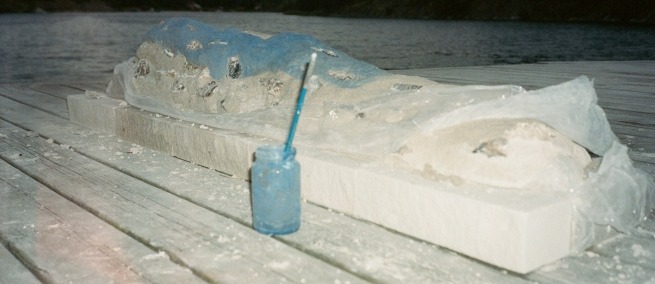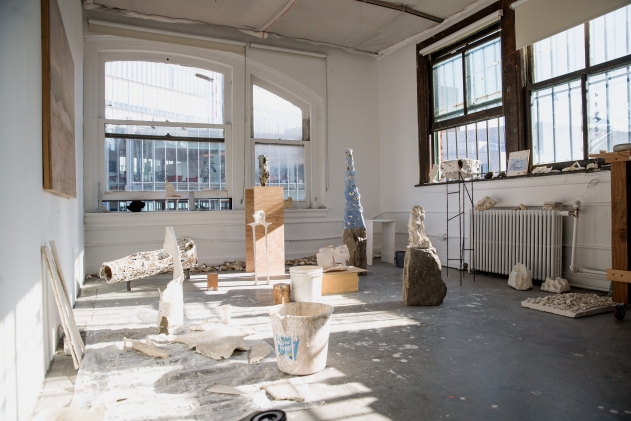
Linnéa Gad is a Swedish artist currently based in New York who works primarily in sculpture but has recently been exploring different media including film. Her art is inspired by the process of marine biogenic calcification – how various sea creatures build up their exoskeletons – and many of her works use materials similar to those that marine organisms use. Her work has been shown at the Jewish Museum in New York, Spencer Brownstone Gallery, at SixtyEight Art Institute in Copenhagen, and her first publication is due out in November. We spoke with Gad about working with organic materials, her impetus for making a film, and her relationship to the sea.
Science & Film: What materials do you work with as a sculptor, and how have you worked with those materials in other kinds of media?
Linnéa Gad: In the past three years, I've been using materials such as shells and other container materials–cardboard and ceramic – inspired by how a mollusk builds up its shell with layers of lime. I've been sculpting in all these different materials following a similar principle, the material almost growing or accumulating. I've been inspired by marine biogenic calcification, where marine organisms build up the structures of their shells through this kind of accumulative calcification.
I first started sculpting only in lime and variations of lime, like lime mortar, oyster shells, limestone, lapis lazuli, and this Japanese pigment Shirayuki. But that turned out to be an intense and almost restrictive prompt – to only sculpt in variations of this material. So I started sculpting in paper, but then I realized that I was following a similar principle; I was using variations of one material; cardboard, paper tape, and then paper pulp. The works ended up looking a like barnacles, which is an example of marine biogenic calcification.
Then moving on to metal, I was welding scraps of sheet metal together and covering them with welding slag similar to how I was covering my cardboard with paper pulp, so again reflecting this accumulative calcification process. Lastly, working in ceramic and dipping bark [bark being another shell material] in ceramic slip which builds up a crust around the bark which burns out in the firing leaving it hollow. Those ceramic works look similar to coral, or something that can grow under sea. The thrilling part is that it’s not something that I thought through like, I'm going to echo the shell in every new material that I work in, but once I let myself be playful in the studio works and materials cross-pollinated.

Mixture of materials and sculptures in process in the artist's studio. Photographed by Linnéa Gad.
S&F: How do you know how a shell builds up?
LG: When working with oysters, you can see how their shells are made from very thin layers of lime. Essentially, mollusks pick up calcium and then carbonate from the sea and they bind to its shell. It cements, and in that way the mollusk builds its shell layer by layer. When you crush a shell, you can see these paper-thin layers that grow bigger over time, like rings on a tree.
S&F: You made a video where you're speaking to your sculpture, and it's very personal. What is your personal relationship to the material?
LG: I often throw myself into working with a material that I've never worked in before. It's always astonished me how much you can learn from just working with a material. You can intuitively understand what something needs or wants. There is a kinship you must make as a sculptor with your material. I was very deep into that when I wrote this letter [that is read in the film]. I wrote the letter also when I was in a crisis, which I express in the video, where I felt like I had to only use lime. It was one of those things I couldn't really figure out for myself, but then when I addressed the sculpture itself, I worked it out.
I also like the idea that my work is alive. Learning about calcium carbonate and the carbon cycle, about different variations of lime...being interested in the ideas of new materialism, I just felt so strongly that this material is actually alive. It is not just a projection, it has a relationship with other organisms. The works contain these narratives as there's so much history embedded in material – not only geological history, but also anthropological, the human hands that hands being in relationship to material over time.
Lastly, I would also say that the sculptures I make that I find the most interesting are the ones that possess a certain character; when there's some humor to them, where they have some sort of personality. Even though my work tends to come across as abstract, there's a sense that maybe they're on the verge of being something.
S&F: Why did you want to make a video piece?
LG: I wrote the letter first and then I had this idea that I wanted to throw my sculptures back into the sea. I had been thinking about, where does my work go? I want there to be a way out for my work, as part of some sort of anxiety about our future or a challenge to think of the work beyond a single lifetime. I made this video where I throw the sculpture into the Hudson River, kind of close to my studio. It felt like I was doing harm to the environment, because whenever you throw something into the sea it feels like this is not what you should do, but it is actually good for that water to get more lime. The New York oyster reefs need lime particles to build their shells. Then it just made sense to pair what seems like a reckless action with the letter about care.
S&F: What are you working on now?
LG: I’m working on my first public sculpture Shoals. Two large-scale sculptures to be installed in Nolan Park on Governors Island in NYC in early September 2023 as part of The Immigrant Artist Biennial and together with Billion Oyster Project. The works will invite visitors to experience wild structures that could provide a good habitat for young oyster spats. Made out of lime mortar with crushed and whole oyster shells over metal armatures, the sculptures may serve as a reminder of New York's involvement in an extensive coastal ecosystem.
♦
Cover image: Lime mortar sculpture painted with lapis lazuli pigment in a buon fresco technique on moist plaster. Photographed by Linnéa Gad.
More from Sloan Science and Film:
TOPICS